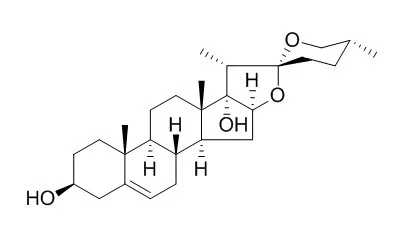| In vitro: |
| Iran J Pharm Res. 2011 Spring;10(2):279-86. | | In-vitro Antitumor Activity and Antifungal Activity of Pennogenin Steroidal Saponins from paris Polyphylla var. yunnanensis.[Pubmed: 24250355] | Paris polyphylla Smith var. yunnanensis, has been used in traditional Chinese medicine for its antibiotic and anti-inflammatory properties; in addition it has been used to cure liver cancer in particular.
METHODS AND RESULTS:
In this current study, β-ecdysterone (1) and three Pennogenin steroidal saponins (2-4) were isolated from the EtOH extract of Paris polyphylla var. yunnanensis, and then tested for their antitumor and antifungal activities. Spectroscopic data was used to confirm their structures. Their antitumor properties were determined by using an MTT assay in addition to ethidium bromide and acridine orange staining techniques. Compounds 2, 3 and 4 exhibited significant anti-proliferation activities against HepG2 cells, with IC50 values of 13.5 μM, 9.7 μM and 11.6 μM respectively, obtained following 48 h treatment. Furthermore, we found these Pennogenin steroidal saponins could induce HepG2 cells apoptosis at a concentration of 20 μM after 48 h treatment. Compounds 2, 3 and 4 were confirmed to exhibit moderate antifungal activity. The minimum inhibitory concentration (MIC) of compounds 2, 3 and 4 against saccharomyces cerevisiae hansen were 2.5 mg.mL(-1), 0.6 mg.mL(-1) and 0.6 mg.mL(-1), respectively. The MIC of compounds 2, 3 and 4 against Candida albicans were 1.2 mgmL(-1), 0.6 mg.mL(-1) and 1.2 mg.mL(-1), respectively. The analysis of the bioactivity-structure relationship shows that the sugar moiety plays a critical role in the activity of steroid moiety.
CONCLUSIONS:
Our results suggest that these three Pennogenin steroidal saponins could be utilized to develop anticancer medicines. | | Molecules . 2016 Aug 20;21(8):1095. | | Beneficial Effects of Trillium govanianum Rhizomes in Pain and Inflammation[Pubmed: 27556434] | | Abstract
Trillium govanianum rhizome is used as an analgesic and anti-inflammatory remedy in traditional medicine in northern Pakistan. In an attempt to establish its medicinal value, the present research evaluated the analgesic and anti-inflammatory potential of T. govanianum. The in vivo anti-inflammatory activity of extract and fractions was investigated in the carrageenan induced paw edema assay. The in vitro suppression of oxidative burst of extract, fractions and isolated compounds was assessed through luminol-enhanced chemiluminescence assay. The in vivo analgesic activity was assayed in chemical and thermal induced nociceptive pain models. The crude methanol extract and its solvent fractions showed anti-inflammatory and analgesic responses, exhibited by significant amelioration of paw edema and relieve of the tonic visceral chemical and acute phasic thermal nociception. In the oxidative burst assay, based on IC50, the crude methanol extract and n-butanol soluble fraction produced a significant inhibition, followed by chloroform and hexane soluble fractions as compared to ibuprofen. Similarly, the isolated compounds Pennogenin and borassoside E exhibited significant level of oxidative burst suppressive activity. The in vivo anti-inflammatory and analgesic activities as well as the in vitro inhibition of oxidative burst validated the traditional use of T. govanianum rhizomes as a phytotherapeutic remedy for both inflammatory conditions and pain. The observed activities might be attributed to the presence of steroids and steroid-based compounds. Therefore, the rhizomes of this plant species could serve as potential novel source of compounds effective for alleviating pain and inflammation.
Keywords: Trilliaceae; analgesic; anti-inflammatory; borassoside E; oxidative burst; Pennogenin. |
|






 Cell. 2018 Jan 11;172(1-2):249-261.e12. doi: 10.1016/j.cell.2017.12.019.IF=36.216(2019)
Cell. 2018 Jan 11;172(1-2):249-261.e12. doi: 10.1016/j.cell.2017.12.019.IF=36.216(2019) Cell Metab. 2020 Mar 3;31(3):534-548.e5. doi: 10.1016/j.cmet.2020.01.002.IF=22.415(2019)
Cell Metab. 2020 Mar 3;31(3):534-548.e5. doi: 10.1016/j.cmet.2020.01.002.IF=22.415(2019) Mol Cell. 2017 Nov 16;68(4):673-685.e6. doi: 10.1016/j.molcel.2017.10.022.IF=14.548(2019)
Mol Cell. 2017 Nov 16;68(4):673-685.e6. doi: 10.1016/j.molcel.2017.10.022.IF=14.548(2019)